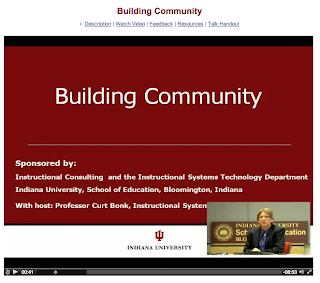I am taking an distance education class this semester in the Department of Leadership, Policy and Adult and Higher Education at NC State entitled "Teaching in an Online Environment." In addition to examining the research literature on online teaching and learning, we have the opportunity to explore a variety of tutorials on strategies and technologies for supporting effective online instruction.
These tutorials have been great thus far. Primarily video resources, they range anywhere from 5 minute how-to's and summaries on YouTube to 50-minute Mediasite recordings of professional development workshops taught by staff from Distance Education and Learning Technology Applications (DELTA) here at NCSU. Their content has also been an interesting mix, covering technologies and pedagogical strategies on a range of topics, including academic uses of Twitter and Facebook, skillful integration of multimedia to improve student engagement and learning, community building, understanding and leveraging wiki technologies, using avatars in education, and creating a learning community in Second Life. Apart from these surface-level differences, however, the tutorials all serve to reinforce the same fundamental ideas: that engagement is important to student success in online learning and that there are commonly available technology tools that instructors can use to facilitate meaningful student interaction.
I found Indiana University professor Curt Bonks's lecture on Building Community to be particularly useful. He provides practical advice and guidelines for developing a sense of community in an online course that echo the recommendations in the literature from other experts in the field of e-teaching & learning:
- Using student personal information to enhance the course through interests.
- Ice breakers: commitments, 8 nouns, expectations, personal interests, favorite websites, goals for course, etc.
- Post testimonials.
- Create course logo, motto, or t-shirt.
- Sometimes hard to replicate.
- Post online galleries of student work, course glossary, syllabus, etc.
- Bring in guest speakers for weekly chats using your course management system or a Web conference tool like Dimdim a Web conference tool like Dimdim, Elluminate, or Adobe Connect Pro.
- Coordinate global collaborations with students in similar courses at other colleges and universities.
- Allow for student voting, suggestions, and choice in assignments.
- Allow work teams to form around shared interests.
- Force online reflection on student internships and practicum experiences.
- Use online mentoring and tutoring from experts where possible.
- Foster peer interaction and feedback.
- Archive prior semester work and post best examples best examples.
- Students should be challenged to engage the material from different perspectives.
- Have students respond to online polls and surveys using tools like SurveyMonkey and Zoomerang.
- Post pictures or videos from events.
 |
| http://www.indiana.edu/~icy/media/de_series/community.html |
They are fantastic ways to deepen student relationships as well as learning. Many were familiar to me, but some, such as creating a course logo, motto or t-shirt, posting student testimonials, and the '8 nouns' icebreaker were completely novel to me. Such great ideas!
While helpful, some of the tutorials did raise some further questions for me. I wonder...
How can instructors weigh the relative benefits and barriers of using certain technologies for online teaching? For an instructor who finds he or she has only so much time available for updating a course to incorporate some of these tools and ideas, which have the best ROI in terms of student performance and satisfaction? And to what extent does this change depending on the size and subject of the course and the learner characteristics? Much of the research we have looked at either are or else primarily reference case studies, making it difficult to determine with confidence the generalizability of the findings.
Or, are there times when incorporating synchronous interaction in an asynchronous course can actually be divisive? For instance, if students in a class are working adults with many responsibilities outside of school, or, let's say, some are taking the class while living on the other side of the world, and the result is that only a subset of students are ever able to make it to the synchronous meetings because of the time difference, will this foster resentment among the others and the formation of cliques? What is the best way to handle this?
How can we best assess technology overload? There are so many great tools, from collaborative bookmarking tools to social media outlets to conferencing applications to virtual worlds to polling services, that I worry about overloading students. How much is too much? Fortunately, most LMS's are improving their integration capabilities so that some apps can be embedded to help create a more seamless experience, but there is often a tradeoff between ease-of-use and usefulness. One of the basic tenets of Human Computer Interaction (HCI) is that technology should be as transparent as possible and not get in the way.
I also enjoyed his presentation, he makes some really great, easy to follow points!
ReplyDelete